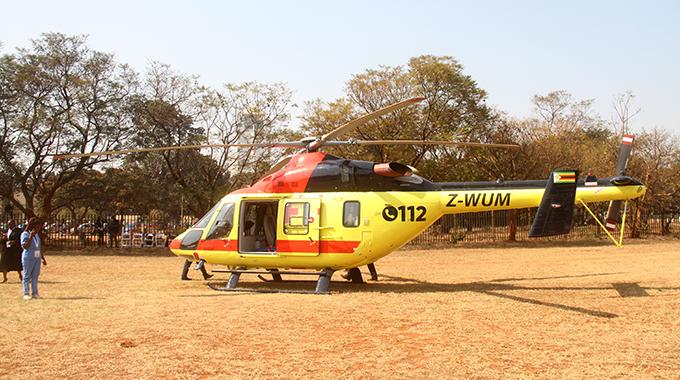News / National
Zimbabwe air ambulance service saves 67 lives since launch
07 Oct 2024 at 06:54hrs |
0 Views

Since its launch in August 2024, the Government's new air ambulance service, operated by Russian company HeliDrive, has saved the lives of 67 patients, including 21 children aged 17 and under. The service, which is funded by the Government, has provided critical emergency medical transport, ensuring patients receive timely care in cases where quick intervention is vital.
The first rescue mission took place on August 24, when a cardiac arrest patient was airlifted from Chegutu District Hospital in Mashonaland West to Sally Mugabe Central Hospital in Harare. Since then, the air ambulance service has been essential in addressing medical emergencies, particularly in rural areas where access to advanced healthcare facilities can be limited.
Children, especially those in the zero to five age group, have been the primary beneficiaries, with 16 infants airlifted for urgent medical attention. Three children between the ages of six and 12, and two between 12 and 17, were also transported to referral hospitals. The majority of the airlifted children suffered from congenital defects requiring surgeries.
HeliDrive Zim medical director Dr. Freddy Mhondiwa highlighted the importance of the service for newborns with congenital issues. "Most of the children we have been airlifting are neonates born with congenital defects who needed corrective surgeries at Sally Mugabe Central and Parirenyatwa Hospitals," said Dr. Mhondiwa.
In total, 64 of the airlifts were hospital transfers, while three were for victims of road traffic accidents. Of the 67 patients, 37 were female, with 43 patients aged between 18 and 64 years and three over 65 years old.
The air ambulance service has primarily served patients from rural provinces such as Mashonaland West and Mashonaland Central. Major referral hospitals, including Parirenyatwa Group of Hospitals and Sally Mugabe Central Hospital, along with Chinhoyi Provincial Hospital, have been at the forefront of receiving the airlifted patients. Chinhoyi Provincial Hospital led the transfers with 16 airlifts, followed by Concession District Hospital (15), Chegutu (12), and Bindura Provincial Hospital (10).
The initiative, part of President Mnangagwa's modernisation drive for Zimbabwe's health sector, is designed to provide critical en route medical care. Six air ambulances, stationed in Harare, Bulawayo, Mutare, and Victoria Falls, are equipped to handle various emergencies and ensure nationwide coverage.
HeliDrive is also training local professionals to operate the service. Forty pilots, 40 doctors, 50 nurses, 10 dispatchers, and 10 engineers are currently undergoing training. The Russian company has also supplied helicopters that will be deployed in the tourism sector.
The air ambulance service comes at a time when Zimbabwe experiences high rates of road traffic accidents. According to the Traffic Safety Council of Zimbabwe (TSCZ), an estimated 4,250 accidents occur on the country's roads each month, many involving young adults aged 25 to 45. The air ambulance service, therefore, plays a crucial role in reducing fatalities by ensuring quick access to life-saving care.
Air ambulances are critical in cases where ground transport is insufficient, enabling patients to be transferred to higher levels of care. They also provide intensive care unit (ICU)-level treatment en route, making them invaluable in emergencies.
The first rescue mission took place on August 24, when a cardiac arrest patient was airlifted from Chegutu District Hospital in Mashonaland West to Sally Mugabe Central Hospital in Harare. Since then, the air ambulance service has been essential in addressing medical emergencies, particularly in rural areas where access to advanced healthcare facilities can be limited.
Children, especially those in the zero to five age group, have been the primary beneficiaries, with 16 infants airlifted for urgent medical attention. Three children between the ages of six and 12, and two between 12 and 17, were also transported to referral hospitals. The majority of the airlifted children suffered from congenital defects requiring surgeries.
HeliDrive Zim medical director Dr. Freddy Mhondiwa highlighted the importance of the service for newborns with congenital issues. "Most of the children we have been airlifting are neonates born with congenital defects who needed corrective surgeries at Sally Mugabe Central and Parirenyatwa Hospitals," said Dr. Mhondiwa.
In total, 64 of the airlifts were hospital transfers, while three were for victims of road traffic accidents. Of the 67 patients, 37 were female, with 43 patients aged between 18 and 64 years and three over 65 years old.
The initiative, part of President Mnangagwa's modernisation drive for Zimbabwe's health sector, is designed to provide critical en route medical care. Six air ambulances, stationed in Harare, Bulawayo, Mutare, and Victoria Falls, are equipped to handle various emergencies and ensure nationwide coverage.
HeliDrive is also training local professionals to operate the service. Forty pilots, 40 doctors, 50 nurses, 10 dispatchers, and 10 engineers are currently undergoing training. The Russian company has also supplied helicopters that will be deployed in the tourism sector.
The air ambulance service comes at a time when Zimbabwe experiences high rates of road traffic accidents. According to the Traffic Safety Council of Zimbabwe (TSCZ), an estimated 4,250 accidents occur on the country's roads each month, many involving young adults aged 25 to 45. The air ambulance service, therefore, plays a crucial role in reducing fatalities by ensuring quick access to life-saving care.
Air ambulances are critical in cases where ground transport is insufficient, enabling patients to be transferred to higher levels of care. They also provide intensive care unit (ICU)-level treatment en route, making them invaluable in emergencies.
Source - The Herald
Join the discussion
Loading comments…





































